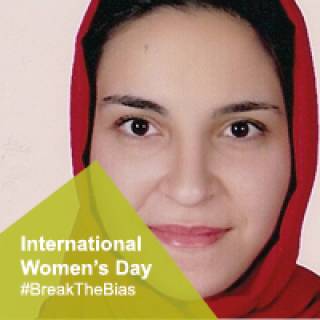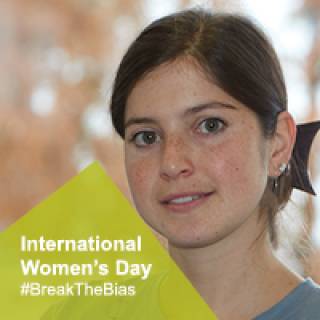Celebrating some of our academics this International Women's Day
8 March 2022
On International Women's Day, we've caught up with some of our female academics to hear more about their research, their inspirations, and their goals for the future.
This year we've caught up with some of our female academics to hear more about their research, their inspirations, and their goals for the future.

Dr Nargess Khalilgharibi grew up in Tehran, Iran. She obtained a BSc in Physics from Sharif University of Technology, and then moved to the UK to study for a MRes in Modelling Biological Complexity at UCL, followed by a multidisciplinary PhD under the supervision of Prof Mark Miodownik and Prof Guillaume Charras, where she studied the mechanics of epithelial tissues. Nargess joined Dr Yanlan Mao’s lab at the LMCB in 2018 to continue her research and have been an NC3Rs Training Fellow since 2020.
What area of your work most excites you and why? I am looking at the role of the extracellular matrix, a protein meshwork that lines most of the body tissues, in defining and maintaining tissue shape. This means that in my research, I am looking at the interface where living matter (cells) meets and interacts with non-living matter (extracellular matrix). This really excites me, because understanding how living and non-living matter differ from each other, and how they interact, has been a fundamental question throughout history.
What first attracted you to your area of research and what advice would you give to younger scientists? During my undergraduate studies, I had a contemporary physics course with Prof Shahin Rouhani. There I got introduced to “biophysics” and learnt that this is where laws of the non-living world (physics) are used to understand the living world (biology). This reminded me of a question that I had from my school days (and which I thought was stupid): I wondered why some matter are living and some are non-living, while they are all made of atoms. After that course and also reading Erwin Schrödinger’s book “What is life?”, I realised that this question is not stupid after all and decided to pursue it by continuing my studies in biophysics.
My advice to younger scientists is to never think a question is stupid! Always ask your questions, and even if you don’t get the chance to ask, always take a note of your questions so you can go back to them.
Which famous female scientist has inspired you? When I was a child, I used to read short biographies of famous people. One of those was the biography of Marie Skłodowska-Curie, where I was inspired by her devotion and dedication to her research. Maryam Mirzakhani, the prominent mathematician who is the only female recipient of the Fields Medal to date, has also been my inspiration since school days, as I was privileged to go to the same secondary/high school as hers, albeit 10 years after her. Although my field of research is completely different to hers, I always remember my teachers talking about her creativity and “thinking out of the box”.
What’s your next big challenge in terms of your research? Doing research is like walking in unknown/undiscovered lands. You gather data that you have to make sense of. Currently, with the advances in both experimental and computational techniques (microscopy, image analysis, computational modelling, machine learning, etc), we are able to gather large amounts of information about the systems we are studying. However, making sense out of them and especially ensuring that what you get from computer algorithms are real representation of the system, are a big challenge.
Where do you see yourself in 5 years? With the competition to get faculty positions and funding becoming harder and harder, and many talented scientists leaving academia in the past few years, it is hard to say where I will be in 5 years. My vision is to run my own independent group and use interdisciplinary approaches to study interactions between living and non-living matter and I will do all my best to realise this vision.

Dr. Giulia Paci is an EMBO Postdoctoral fellow at the Laboratory for Molecular Cell Biology, in the labs of Yanlan Mao and Buzz Baum. She is interested in understanding the interplay between mechanical forces and molecular processes across biological scales. She has a background in Physics from the University of Bologna, Italy and completed her PhD at EMBL Heidelberg, Germany.
What area of your work most excites you and why? In my research I study how tissues manage to cope with mechanical forces experienced during development, and my experiments often involve applying mechanical perturbations to tissues and observing them at a high resolution to see how the cells respond. Using microscopes to look at live biological processes is still one of the parts of my work I find most exciting: the idea that you’re sitting there peeking into the inner workings of a cell while they are unfolding still amazes me after many years! In one of my past projects, I helped develop an educational “kit” to introduce high-school students to fluorescence microscopy by building a simple and fully functioning microscope from scratch with their own hands – I hope resources like this can encourage even more people to get interested in microscopy.
What first attracted you to your area of research and what advice would you give to younger scientists? The path to my current research topic hasn’t been very linear: while I have always been very fond of science, my interests have changed a lot during the years! When I enrolled in my Physics’ bachelor I thought I would become an astrophysicist, but found myself getting more and more attracted to applied areas of physics and finally jumped into the life sciences for my PhD at EMBL. As a biophysicist, I currently integrate all these past experiences into my current work and I find that my own training across disciplines has really helped me in learning how to communicate with people in different fields. I would encourage younger scientists and students to nurture their curiosity and always remain open-minded, allowing room for serendipity in their journeys.
Which famous female scientist has inspired you? Probably the Italian astrophysicist Margherita Hack, who I was lucky to meet at a series of lectures when I was a first-year physics student. She was 86 years old at the time and I was struck by her liveliness and personality, determined and cheerful at the same time. She was also a passionate science communicator and tireless civil rights champion, which I’ve always found very inspiring, far from the widespread stereotype of physicists as “solitary geniuses” who are uninterested in the daily struggles of people.
What’s your next big challenge in terms of your research? In the area of cell and tissue mechanics we now have several methods available to manipulate the external forces experienced by cells, either by altering their environment (e.g. making it stiffer) or mechanically deforming them (e.g. stretch/compression). However, we still don’t have a very good idea of the magnitudes and timescales at which forces operate during development inside living organisms. The big challenge will be developing new tools that would enable us to map mechanical forces in vivo and we’ve started exploring ways to do this in the fruit fly using in vivo imaging and/or molecular reporters.
Where do you see yourself in 5 years? During the next few years I look forward to further expanding my research avenues and gaining independence, with the goal of leading my own group at a UK University. One of the aspects of academia I enjoy the most are the personal connections and daily interactions with colleagues, and I can’t wait to share future ideas, achievements, and challenges together with my team.
 Close
Close

